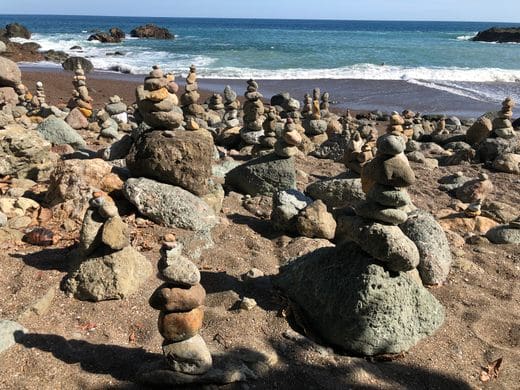A Beach Transformed by Tradition: The Legacy of Jake and the Cairns of Piedra Colorada a Tribute to Conservationist Nicolas Wessberg
Decades ago, Jake embarked on a unique daily ritual that would leave a lasting mark on the Piedra Colorada area of the Southern Nicoya Peninsula. Each day, he visited the shoreline to craft balanced rock statues, known as cairns. These delicate and often intricate sculptures, created from the beach’s naturally scattered stones, became a mesmerizing testament to balance and patience. Jake’s dedication saw him return daily to repair the statues that had been knocked over by the tides and to add new creations, ensuring the collection grew and evolved continuously.
After Jake eventually moved away, his artistic tradition did not fade. Travelers and locals alike took up the mantle, perpetuating the creation of these stone monuments. The cairns, which now dot the shoreline, have become a symbol of tranquility and persistence, their quiet presence surrounding the final resting place of Nicolas Wessberg.
Wessberg, together with his wife Karen Mogensen, played a pivotal role in Costa Rica’s environmental movement. Their efforts in the early 1970s led to the establishment of the Cabo Blanco Absolute Natural Reserve, the country’s first protected nature reserve. Today, the reserve features two trails named in their honor—the Swede’s Path and the Dane’s Trail, reflecting their Scandinavian roots. Their work set a precedent that inspired many international environmentalists to follow suit, purchasing land throughout Costa Rica to protect its rich and diverse ecosystems.
This commitment to conservation has borne fruit, as Costa Rica is now home to two UNESCO World Heritage Sites. However, the path to this recognition was fraught with challenges. In 1975, Karen Mogensen discovered her husband’s remains near Corcovado, a testament to the dangers they faced. It is widely believed, though never proven, that Wessberg was murdered by individuals seeking to exploit the very land he sought to protect. Today, a plaque stands amidst the cairns at Piedra Colorada, commemorating the couple’s tireless efforts and their vision for a sustainable future.



Prepare before you go
Visitors to the area can immerse themselves in this blend of art and conservation. The journey to the sculpture garden begins with a 20-minute walk north from the town center along the picturesque Gulf of Nicoya. The path offers two options: a serene walk along the beach or a partially shaded nature trail. For those standing in the water facing the cairns, a tranquil stream can be seen to the left. This shallow stream is perfect for children to play in, and those who follow it further inland will discover a charming small waterfall. As there are no facilities nearby to purchase water or food, visitors should come prepared to enjoy their time in this serene and historically rich location.
By preserving the tradition of the cairn building, visitors not only contribute to a beautiful and evolving art form but also honor the legacy of those who fought to protect Costa Rica’s natural beauty.JTNDaWZyYW1lJTIwc3JjJTNEJTIyaHR0cHMlM0ElMkYlMkZ3d3cuZ29vZ2xlLmNvbSUyRm1hcHMlMkZlbWJlZCUzRnBiJTNEJTIxMW0xNCUyMTFtOCUyMTFtMyUyMTFkMTMyMzMuNzk5NDU3NzU5ODExJTIxMmQtODUuMDYxMzcwNiUyMTNkOS42NTgzNDMxJTIxM20yJTIxMWkxMDI0JTIxMmk3NjglMjE0ZjEzLjElMjEzbTMlMjExbTIlMjExczB4OGY5ZjY0ZGQ2OWFiMDA0NSUyNTNBMHgzYjRmOWY3NzFkZmYyMWFmJTIxMnNQaWVkcmElMjUyMENvbG9yYWRhJTIxNWUxJTIxM20yJTIxMXNlcy00MTklMjEyc2NyJTIxNHYxNzE5MTk5MTk4ODY3JTIxNW0yJTIxMXNlcy00MTklMjEyc2NyJTIyJTIwd2lkdGglM0QlMjI2MDAlMjIlMjBoZWlnaHQlM0QlMjI0NTAlMjIlMjBzdHlsZSUzRCUyMmJvcmRlciUzQTAlM0IlMjIlMjBhbGxvd2Z1bGxzY3JlZW4lM0QlMjIlMjIlMjBsb2FkaW5nJTNEJTIybGF6eSUyMiUyMHJlZmVycmVycG9saWN5JTNEJTIybm8tcmVmZXJyZXItd2hlbi1kb3duZ3JhZGUlMjIlM0UlM0MlMkZpZnJhbWUlM0U=






